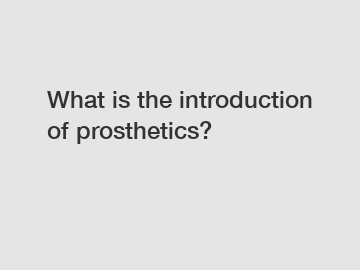What is the introduction of prosthetics?
What are prosthetics?
Prosthetics are artificial limbs or body parts designed to replace missing or damaged body parts. They are custom-made to fit each individual's unique needs and provide support, mobility, and function. Prosthetics can be used for a variety of purposes, including enhancing mobility, improving quality of life, and restoring independence.
Types of prosthetics.

There are several types of prosthetics available, depending on the specific needs of the individual. Some common types of prosthetics include:
1. Upper limb prosthetics: These prosthetics are designed to replace missing or damaged arms, hands, or fingers. They can be controlled using body movements or electronic signals to mimic the natural movements of the limb.
2. Lower limb prosthetics: These prosthetics are used to replace missing or damaged legs, feet, or toes. They can be customized to provide stability, balance, and support for walking, running, or other activities.
3. Cosmetic prosthetics: These prosthetics are designed to improve the appearance of the body part and restore self-confidence. They are often used to replace missing or damaged facial features, such as ears, noses, or eyes.
Benefits of prosthetics.
Prosthetics offer a wide range of benefits for individuals who have lost a limb or body part. Some of the key benefits of prosthetics include:
- Improved mobility: Prosthetics can help individuals regain their independence and move more freely.
- Enhanced quality of life: Prosthetics can improve overall well-being and self-esteem by restoring function and appearance.
- Increased opportunities: Prosthetics can open up new opportunities for work, education, and social activities.
- Personalized care: Prosthetics are tailored to each individual's specific needs and goals, ensuring a customized fit and function.
Challenges of prosthetics.
While prosthetics offer many benefits, there are also some challenges to consider. Some common challenges of prosthetics include:
- Cost: Prosthetics can be expensive, and not all insurance plans cover the full cost of prosthetic devices.
- Maintenance: Prosthetics require regular care and maintenance to ensure optimal function and longevity.
- Adjustment: It can take time to adjust to using a prosthetic limb and learn how to control it effectively.
Overall, prosthetics play a crucial role in helping individuals with limb loss or limb damage regain function, independence, and confidence. If you or someone you know is in need of prosthetic care, don't hesitate to reach out to a trusted supplier for guidance and support.
In conclusion, prosthetics are a remarkable technology that has the power to change lives and improve quality of life for individuals with limb loss or limb damage. If you have any questions about prosthetics or would like to learn more about how they can benefit you or a loved one, feel free to contact us or reach out to a reputable supplier for assistance. Remember, you're not alone in this journey – help is always available when you need it.
For more low ankle carbon fiber foot supplier, Sach Foot with Plastic Core and Adapter, Spring lock Orthoticsinformation, please contact us. We will provide professional answers.
232
0
0

Comments
All Comments (0)